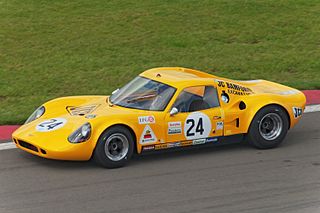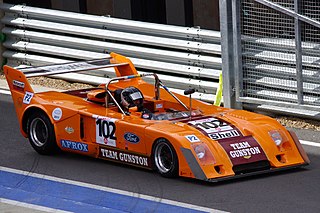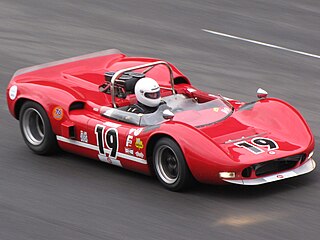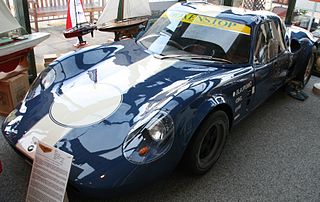Lola Cars International Ltd. was a British race car engineering company in operation from 1958 to 2012. The company was founded by Eric Broadley in Bromley, England, before moving to new premises in Slough, Buckinghamshire and finally Huntingdon, Cambridgeshire, and endured for more than fifty years to become one of the oldest and largest manufacturers of racing cars in the world. Lola Cars started by building small front-engined sports cars, and branched out into Formula Junior cars before diversifying into a wider range of sporting vehicles. Lola was acquired by Martin Birrane in 1998 after the unsuccessful MasterCard Lola attempt at Formula One.

The 24 Hours of Daytona, also known as the Rolex 24 At Daytona for sponsorship reasons, is a 24-hour sports car endurance race held annually at Daytona International Speedway in Daytona Beach, Florida. It is run on the Sports Car Course layout, a 3.56-mile (5.73 km) combined road course, utilizing portions of the tri-oval and an infield road course. Since its inception, it has been held on the last weekend of January or first weekend of February as part of Speedweeks, and it is the first major automobile race of the year in North America. The race is sanctioned by IMSA and is the first race of the season for the IMSA SportsCar Championship.

Formula 5000 was an open wheel, single seater auto-racing formula that ran in different series in various regions around the world from 1968 to 1982. It was originally intended as a low-cost series aimed at open-wheel racing cars that no longer fit into any particular formula. The '5000' denomination comes from the maximum 5.0 litre engine capacity allowed in the cars, although many cars ran with smaller engines. Manufacturers included McLaren, Eagle, March, Lola, Lotus, Elfin, Matich and Chevron.

Chevron Cars Ltd. is an English manufacturer of racing cars, founded by Derek Bennett in 1965. Following Bennett's death in 1978, the firm has remained active in various guises. The original company's designs and name continue to be used to build replacement parts and continuation models of earlier Chevrons. In 2000, Chevron Racing Cars Ltd., founded by Vin Malkie acquired the trade mark Chevron Racing Cars Ltd and in addition to the company's other activities has designed and built new grand tourer racing cars under the Chevron name, as well as other continuation models of earlier Chevrons.
The National Series for Sports Sedans, formerly the Australian Sports Sedan Championship, is a CAMS sanctioned national motor racing title for drivers of cars complying with Australian Sports Sedan regulations. This class, essentially a silhouette racing car class, caters for cars of essentially free construction but utilising some of the bodywork of a closed, series production vehicle.

The Chevron B21 is a 2-liter Group 5 sports prototype race car, designed, developed and built by British manufacturer Chevron, in 1972. Over its racing career, spanning 13 years, it won a total of 23 races, scored 45 podium finishes, and clinched 11 pole positions. It was powered by a naturally-aspirated 2.0 L (120 cu in) Ford-Cosworth BDG, or BMW M12/7, four-cylinder engine, both making around 275 hp (205 kW). Only 28 cars were built.

The Chevron B23 is a Group 6 sports prototype race car, designed, developed and built by British manufacturer Chevron, in 1973. Over its racing career, spanning 12 years, it won a total of 12 races, scored 41 podium finishes, and clinched 2 pole positions. It was powered by a naturally-aspirated 3.0 L (180 cu in) Ford-Cosworth DFV Formula One engine, producing 398 hp (297 kW).

The Chevron B8 is a lightweight sports racing car, designed, developed and built by British manufacturer Chevron Cars, in 1968. It is homologated in the Prototype category of the International Automobile Federation.It won thirty-six races during her various engagements. Only 44 cars were built.

The Chevron B26 is a 2-liter Group 6 sports prototype race car, designed, developed and built by British manufacturer Chevron, in 1973. Over its racing career, spanning 14 years, it won a total of 17 race wins, achieved 43 podium finishes, and clinched 9 pole positions. It was powered by a naturally-aspirated 2.0 L (120 cu in) Hart 420R four-cylinder engine, developing 285 hp (213 kW).

The Chevron B28 was an open-wheel race car, designed, developed and built by British Manufacturer Chevron, for Formula 5000 racing, in 1973. It was driven by Peter Gethin, Teddy Pilette, Vern Schuppan, and Chris Craft. Briton Peter Gethin won 4 races in the 1974 season with the B28, eventually finishing second place, as runner-up in the championship, with 186 points. Gethin's Belgian teammate, Teddy Pilette, would finish fourth place in the championship, with 108 points. Chevron only produced two finished models of the B28. It did compete at the non-championship Race of Champions Formula One race, being driven by Peter Gethin, and its best result there was a 10th-place finish. It was later converted into a closed-wheel prototype-style car, and used in the revived Can-Am series in North America. As with most other cars of the time, it was powered by the commonly used Chevrolet small-block engine.

The Chevron B24 was a Formula 5000 racing car developed by Chevron Cars in 1972.

The McLaren M1A, and its derivatives, the McLaren M1B and the McLaren M1C, are a series of mid-engined Group 7 sports prototype race cars built by McLaren, between 1963 and 1968. The M1A was the team's first self-designed and developed sports car. Later versions, such as the 'M1B' and 'M1C', competed and raced in the North American Can-Am series, starting in 1966 season. The car was raced in North America and Europe in 1963 and 1964 in various Group 7 and United States Road Racing Championship series events. 24 examples of the M1A and M1B were built, and 25 examples of the M1C were manufactured. They were powered by a few different motors, including Chevrolet small-block engine, an Oldsmobile V8 engine, a Chevrolet big-block engine, and even a Ford FE engine. It was constructed out of a tubular space frame chassis, and, combined with its light weight of 551 kg (1,215 lb) this gave it a great power-to-weight ratio. The 4.5 L (270 cu in) Oldsmobile V8 engine developed around 310 hp (230 kW), while the 350 cu in (5.7 L) Chevrolet small-block V8 engine was capable of developing over 550 hp (410 kW), and 538 lb⋅ft (729 N⋅m) of torque. This drove the rear wheels through a Hewland L.G.400 four-speed manual transmission.

The Chevron B36 was a Group 6 prototype sports car, designed, developed, and built by British manufacturer Chevron Cars in 1976 and used in sports car racing until 1987. Over that time period, it won a total of 14 races, and achieved 43 podium finishes.

The Chevron B16 was a Group 4 sports prototype race car, designed, developed, and built in 1969 by the British racing car manufacturer Chevron Cars as a two-seater racing sports car for the makes world championship. Brian Redman won the very first outing, the 500 km (310 mi) race at the Nürburgring on September 7, 1969, at a time of 3:13:01.6 hours. The last victory with a Chevron B16 was achieved by Clemens Schickentanz on July 11, 1971, in the sports car race at the Norisring.
The Chevron B6 is a lightweight sports racing car, designed, developed and built by British manufacturer Chevron Cars, in 1967. Only 7 cars were built, which makes it very rare. Over its career, spanning 8 years, it won a total of 15 races, plus 4 additional class wins, clinched 1 pole position, and scored 30 total podium finishes.

The Chevron B1 was the first car to be developed and built by British manufacturer Chevron, in 1965. Designed by Derek Bennett, it was lightweight open-wheel sports car, specifically intended and purpose-built to compete in the clubman class series of racing; a series for front-engined sports prototypes. Over its five-year career span, it won 7 races, scored 18 podium finishes, won an additional 8 races in its class, and scored one single pole position. Only two car were built. It was constructed out of a steel tubular spaceframe chassis, covered in aluminum body panels. This meant it was very light, weighing only 400 kg (880 lb). It was powered by a naturally-aspirated 1,498 cc (91.4 cu in) Ford-Cosworth.

The Chevron B19 is a 2-liter sports prototype race car, designed, developed and built by British manufacturer Chevron in 1971. Only 35 cars were built.

The Chevron B5 is a sports racing car, designed and developed by British manufacturer Chevron, and built by David Bridges, in 1967. Only one single car was constructed. It was powered by a naturally-aspirated 2.0 L (120 cu in) BRM V8 engine. Over its racing career, spanning 4 years, it won a total of 3 races, and scored 7 podium finishes.
The Chevron B4 was the second sports racing car to be developed and built by British manufacturer Chevron, in 1966. It was designed by British engineer, Derek Bennett. It was powered by a naturally-aspirated BMW M10 four-cylinder engine. Over its racing career, spanning two years, it only managed to score one class win, with its best race result being a 4th-place finish. Only one single model was built.
The Chevron B3 was the first sports racing car that was developed and built by British manufacturer Chevron, in 1966. It was designed by British engineer, Derek Bennett. It was powered by a naturally-aspirated 1.6 L (98 cu in) Ford twin-cam four-cylinder engine. Over its racing career, spanning two years, it won a respectable 8 races, and took 10 podium finishes.















